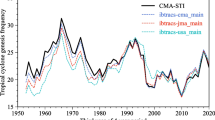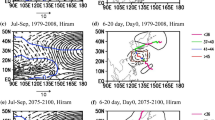Abstract
The interdecadal variations in extratropical anticyclone activity over East Asia during the winters of 1958–2013 were analysed using an objective identification and tracking algorithm for anticyclones. The influence of the interdecadal variation in anticyclone activity over the Mongolian Plateau on the interdecadal variation in East Asian surface air temperature and its possible mechanism was studied. The results showed that the Mongolian Plateau is the key region of anticyclonic activity in East Asia, and the occurrence frequency of anticyclones presented significantly opposite distribution forms in the higher and lower latitudes. An abrupt change in anticyclone activity over the Mongolian Plateau occurred in the late 1970s. From 1958 to the late 1970s, the main anticyclone activity occurred farther northward, whereas the activity was farther southward from the 1980s to 2013. Further study showed that in the period when the anticyclone occurrence frequency in the higher latitudes north of 50°N was lower (higher), while that in the lower latitudes south of 50°N was higher (lower), the surface air temperature of most parts of East Asia, especially the middle and high latitudes, was abnormally high (low). This was due to the anticyclonic activities, the Siberian high faded in the northwest part and expanded in southeast, while the East Asia trough and Ural Mountain blocking high weakened. This was also manifested as the variation in the geopotential height tendency forcing by transient waves. As the anticyclonic wave-breaking intensifies from western Mongolia to Northeast China, the high-frequency momentum flux over this area was significantly enhanced, strengthening the west wind in the higher latitudes from the north side and weakening the west wind in the middle latitudes from the south side. Under the combined force of the above activity, the southward movement of polar cold air was weakened, and the warm air in the middle and low latitudes was more easily transported to the north, resulting in warmer surface air temperatures over most parts of East Asia.











Similar content being viewed by others
References
Chen L, Tan B, Kvamst NG, Johannessen OM (2014) Wintertime cyclone/anticyclone activity over China and its relation to upper tropospheric jets. Tellus A 66:1–17
Chen HS, Teng FD, Zhang WX (2017) Impacts of anomalous mid-latitude cyclone activity over East Asia during summer on the decadal mode of East Asian summer monsoon and its possible mechanism. J Clim 30:739–753
Cheung Zhou W, Lee S, Tong H (2014) Interannual and Interdecadal Variability of the number of cold days in Hong Kong and their relationship with large-scale circulation. Mon Wea Rev 143:1438–1454
Dee DP, Coauthors (2011) The ERA-Interim reanalysis: configuration and performance of the data assimilation system. Quart J Roy Meteor Soc 137:553–597
Ding YH (1990) Build-up, air mass transformation and propagation of Siberian high and its relation to cold surge in Ease Asia. Meteor Atmos Phys 44:281–292
Favre A, Gershunovm A (2006) Extra-tropical cyclonic/anticyclonic activity in North-Eastern pacific and air temperature extremes. Climate Dyn 26:617–629
Godev N (1971) Anticyclonic activity over south Europe and its relationship to orography. J Appl Meteor 10:1097–1102
Goossens CH, Berger A (1986) Annual and seasonal climatic variations over the Northern hemisphere and Europe during the last century. Ann Geophys 4:385–400
Hatzaki M, Flocas HA, Simmonds I et al (2014) Seasonal aspects of an objective climatology of anticyclones affecting the Mediterranean. J Clim 27:9272–9289
Huang W, Wang B, Wright BS (2016J) A potential vorticity-based index for the East Asian winter monsoon. J Geophys Res Atmos 121:9382–9399. https://doi.org/10.1002/2016JD025053
Huesmann AS, Hitchman MH (2003) The 1978 shift in the NCEP reanalysis stratospheric quasibiennial oscillation. Geophys Res Lett 30(2):1048. https://doi.org/10.1029/2002GL016323
Ioannidou L, Yau MK (2008) A climatology of the Northern hemisphere winter anticyclones. J Geophys Res 113:693–702
Jones DA, Simmonds I (1994) A climatology of Southern hemisphere anticyclones. Climate Dyn 10:333–348
Kalnay E, Kanamitsu M, Kistler R (1996) The NCEP/NCAR 40-year reanalysis project. Bull Amer Meteor Soc 77:437–471
Kim YH, Kim MK, Lau WK, Kim KM, Cho CH (2015) Possible mechanism of abrupt jump in winter surface air temperature in the late 1980sover the Northern Hemisphere. J Geophys Res Atmos 120:12474–12485
Kistler R, Kalnay E, Collins W, Saha S, White G, Woollen J, Chelliah M, Ebisuzaki W, Kanamitsu M, Kousky V, Dool HV, Jenne R, Fiorino M (2001) The NCEP/NCAR 50-Year reanalysis: monthly means CD-ROM and documentation. Bull Amer Meteor Soc 82:247–267
Lau NC (1988) Variability of the observed midlatitude storm tracks in relation to low-frequency changes in the circulation pattern. J Atmos Sci 45:2718–2743. https://doi.org/10.1175/1520-0469(1988)045%3c2718:VOTOMS%3e2.0.CO;2
Lau NC, Holopainen EO (1984) Transient eddy forcing of the time-mean flow as identified by geopotential tendencies. J Atmos Sci 41:313–328. https://doi.org/10.1175/1520-0469(1984)041%3c0313:TEFOTT%3e2.0.CO;2
Lau NC, Nath MJ (1991) Variability of the baroclinic and barotropic transient eddy forcing associated with monthly changes in the midlatitude storm tracks. J Atmos Sci 48:2589–2613. https://doi.org/10.1175/1520-0469(1991)048%3c2589:VOTBAB%3e2.0.CO;2
Li F, Wang H (2014) Eurasian snow depth, autumn Arctic sea ice cover and East Asian winter monsoon. Int J Clim 34:3616–3625
Liu G, Ji LR, Sun SQ, Xin YF (2012) Low- and mid-high latitude components of the East Asian Winter Monsoon and Their reflecting variations in winter climate over Eastern China. Atmos Oceanic Sci Lett 5:195–200
Luo X, Zhang YC (2015) The linkage between upper-level jet streams over East Asia and East Asian winter monsoon variability. J Climate 28:9013–9028. https://doi.org/10.1175/JCLI-D-15-0160.1
Mann HB (1945) Non-Parametric test against trend. Econometrika 13:245–259
Müller GV, Gan MA, Piva ED, Silveira VP (2015) Energetics of wave propagation leading to cold event in tropical latitudes of South America. Clim Dyn 45:1–20. https://doi.org/10.1007/s00382-015-2532-2
North GR, Bell TL, Cahalan F (1982) Sampling errors in the estimation of empirical orthogonal function. Mon Wea Rev 110:699–706
Ou T, Chen D, Jeong JH, Linderholm HW, Zhou TJ (2015) Changes in winter cold surges over Southeast China: 1961 to 2012. J Atmos Sci 51:29–37
Panagiotopoulos F, Shahgedanova M, Hannachiand A, Stephenson DB (2005) Observed trends and teleconnections of the Siberian high: a recently declining center of action. J Clim 18:1411–1422
Pezza AB, Simmonds I, Renwick JA (2007) Southern Hemisphere cyclones and anticyclones: recent trends and links with decadal variability in the Pacific Ocean. Int J Clim 27:1403–1419
Pfahl S (2014) Characterising the relationship between weather extremes in Europe and synoptic circulation features. Nat Hazards Earth Syst Sci 14:1461–1475. https://doi.org/10.5194/nhess-14-1461-2014
Pinto JG, Brucher T, Fink AH, Kruger A (2007) Extraordinary snow accumulations over parts of central Europe during the winter of 2005/2006 and weather-related hazards. Weather 62:16–21
Qian WH, Lin X (2004) Regional trends in recent temperature indices in China. Clim Res 27(2):119–134
Riviere G, Orlanski I (2007) Characteristics of the Atlantic storm-track eddy activity and its relation with the North Atlantic Oscillation. J Atmos Sci 64:241–266
Sinclair MR (1996) A climatology of anticyclones and blocking for the Southern Hemisphere. Mon Wea Rev 124:245–263
Song L, Wang L, Chen W, Zhang Y (2016) Intraseasonal variation of the strength of the East Asian trough and its climatic impacts in boreal winter. J Clim 29:2557–2577
Sun JQ, Wu S, Ao J (2016) Role of the North Pacific sea surface temperature in the East Asian winter monsoon decadal variability. Clim Dyn 46:3793–3805
Takaya K, Nakamura H (2005) Mechanisms of intraseasonal amplification of the cold Siberian high. J Atmos Sci 62:4423–4440
Tennant W (2004G) Considerations when using pre-1979 NCEP/NCAR reanalysis in the southern hemisphere. Geophys Res Lett 31:L11112. https://doi.org/10.1029/2004GL019751
Trenberth KE (1986) An Assessment of the impact of transient eddies on the zonal flow during a blocking episode using localized Eliassen-Palm flux diagnostics. J Atmos Sci 43:2070–2087
Trigo IF (2006) Climatology and Interannual variability of storm-tracks in the Euro-Atlantic sector: a comparison between ERA-40 and NCEP/NCAR reanalysis. Clim Dyn 26(2/3):127–143
Wang L, Chen W (2014) An intensity index for the East Asian winter monsoon. J Clim 27:2361–2374
Wang L, Chen W, Huang R (2008) Interdecadal modulation of PDO on the impact of ENSO on the East Asian winter monsoon. Geophys Res Lett 35:L20702
Wang D, He JH, Qi L et al (2015) Temperature characteristics of Eurasia in autumn and winter and its causes under global warming mitigation (in Chinese). J Meteorol Sci 35(5):534–542
Wang XL, Feng Y, Chan R et al (2016) Inter-comparison of extra-tropical cyclone activity in nine reanalysis datasets. Atmos Res 181:133–153
Wen M, Yang S, Kumar A, Zhang P (2009) An analysis of the large-scale climate anomalies associated with the snowstorms affecting China in January 2008. Mon Weather Rev 137:1111–1131
Yang L, Wang DX, Huang J, Wang X et al (2015) Toward a mesoscale hydrological and marine meteorological observation network in the South China Sea. Bull Amer Meteor Soc 96(7):1117–1135
Zhang Y, Sperber KR, Boyle JS (1997) Climatology and interannual variation of the East Asian winter monsoon: results from the 1979–95 NCEP/NCAR reanalysis. Mon Wea Rev 125:2605–2619
Zhang YX, Ding YH, Li QP (2012a) A Climatology of extratropical cyclones over East Asia during the years of 1958–2001. Acta Meteor Sinica 3:261–277
Zhang XD, Lu CH, Guan ZY (2012b) Weakened cyclones, intensified anticyclones and recent extreme cold winter weather events in Eurasia. Environ Res Lett 7:1–7
Zhang YJ, Gao ZQ, Pan ZT, Li D, Huang XH (2017) Spatiotemporal variability of extreme temperature frequency and amplitude in China. Atmos Res 185:131–141
Zhao N, Liang SJ, Ding YH (2014) Underlying low-order dynamics of nonlinear interaction among Northern Hemisphere teleconnection patterns and its association with the AO/NAM. J Clim 27:1315–1335
Zhi XF, Shi XJ (2006) Interannual variation of blockings in Eurasia and its relation to the flood disaster in the Yangtze River Valley during boreal summer. In: Abstracts of tenth WMO international symposium on meteorological education and training, Nanjing, China 2006:21–26
Zhou W, Chan JC, Chen W, Ling J, Pinto JG, Shao P (2009) Synoptic-scale controls of persistent low temperature and icy weather over southern China in January 2008 Mon. Weather Rev 137:3978–3991
Zuo JQ, Ren HL, Wu BY, Li WJ (2016a) Predictability of winter temperature in China from previous autumn Arctic sea ice. Clim Dyn 47:2331–2343
Zuo JQ, Ren HL, Li WJ, Wang L (2016b) Interdecadal variations in the relationship between the winter North Atlantic oscillation and temperature in South-Central China. J Clim 29:7477–7493
Acknowledgements
This study was supported by the National Basic Research “973’’ Program of China (2012CB955200), Ph.D. Foundation Project of Tianjin Meteorological Bureau (201916bsjj02), and the Probability Forecast of Extended 10-15d Weather Based on Different multi-mode Integration Schemes (41575104). We are also grateful to the meteorological observatory of Nanjing University of Information Science and Technology for providing the historical meteorological data. We also thank Professor Zhang Wenjun for his advice.
Author information
Authors and Affiliations
Corresponding author
Additional information
Responsible Editor: E.-K. Jin.
Publisher's Note
Springer Nature remains neutral with regard to jurisdictional claims in published maps and institutional affiliations.
Electronic supplementary material
Below is the link to the electronic supplementary material.
Rights and permissions
About this article
Cite this article
Zhi, X., Tian, X., Liu, P. et al. Interdecadal variations in winter extratropical anticyclones in East Asia and their impacts on the decadal mode of East Asian surface air temperature. Meteorol Atmos Phys 131, 1763–1775 (2019). https://doi.org/10.1007/s00703-019-00684-7
Received:
Accepted:
Published:
Issue Date:
DOI: https://doi.org/10.1007/s00703-019-00684-7




